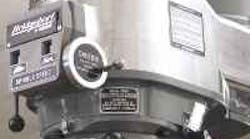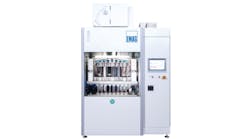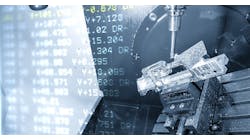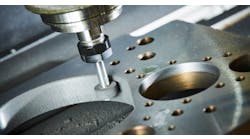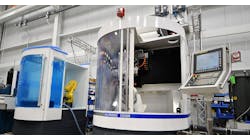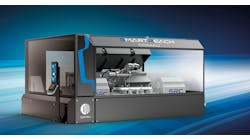The Bridgeport knee mill is back --- and still made in the U.S.A.
By Patricia L. Smith,
managing editor
The Bridgeport knee mill is still made in the U.S.A. — by Hardinge Inc.
Bridgeportarea-team members stand with the first machine to roll off the line at Hardinge.
The Vari-Disc cell area (A) illustrates flowline manufacturing in action. The cell takes up 1/10th the floorspace it did before and requires only one operator. Hardinge eliminated three machines by slotting its own lathes (B) into the process. The new lathes provide the machining precision needed (C) to eliminate a grinding operation (D). The final product, the Vari-Disc (E), goes into the Bridgeport's 2J head.
Team members in the Bridgeport focused factory have 10-min "toolbox" meetings every day and on every shift to discuss daily activities and resolve problems on the line.
When Bridgeport Machines closed its Connecticut headquarters last year, it looked like the end of the line for the venerable Bridgeport mill. But enter Hardinge Inc., which mobilized to bring the entire manufacturing line into its Elmira, N.Y., facility. The job was not as simple as moving a few pieces of equipment and restarting production, however. The machine tool builder had a strict deadline — just nine short weeks — to roll the first mill off its new line. And if the move wasn't enough, Hardinge also streamlined operations, condensing nearly the same capacity into 1/10th the area used previously.
"We brought the Bridgeport operation into Elmira to improve the capacity utilization of this facility and to employ the talent we have here," says J. Patrick Ervin, Hardinge president and CEO. "We also feel strongly that it was important to carry on the Bridgeport name as a U.S.-built product."
After signing a licensing agreement with UK-based Bridgeport Machines Ltd., Hardinge got to work. A team of its engineers and production personnel traveled to Bridgeport's U.S. facility in late November and early December to better understand the product and its production. The team members wanted to transplant the process intact, while improving manufacturing and maintaining or bettering product quality.
The integration went smoothly, but it required a great deal of effort. "Remember that Bridgeport stopped production in June of last year," comments Rick Elliott, Bridgeport division manager. "The first thing we had to do was re-engage the supply chain and get those parts flowing." In the meantime, the team was also reviewing the inventory in the plant, deciding what machines to keep and which to discard, and settling on a plant-floor layout at the Hardinge facility.
Hardinge put the first machines on the floor around the first of this year, with most of it in place and wired by mid-February. The builder staged machine delivery so that it could get certain cells up in sequence. Production started, and on March 6, the first machine rolled off the assembly line. That machine went to Westec.
"Customers didn't believe that Hardinge made the machine," recalls Douglas Rich, vice president-general manager of U.S. machine operations. "They thought it was left over from the Bridgeport facility because they didn't believe we could get the operation up and running in such a short time."
To accomplish its goals, Hardinge relied on the expertise of its people, key personnel from Bridgeport Machine, and outside partners, which it calls its "virtual team." We knew that to make the transition quickly, we would have to partner up with key players," says Rich. "Our virtual organization included the JCIT Training Institute, which helped us with the layout for flow manufacturing; Allspec, a coating partner; Zeller Electric, an electronics partner; Skico, a component-part manufacturer; and Koster Industries, a liquidator. But the number one team member was Machine Tool Builders of New England, which now makes the 2J head. This group is headed up by Leon Tyrrell and a group of employees who worked at Bridgeport Machines."
Once the virtual team was in place, Hardinge got to work condensing the operating area of 144,000 ft2 to just 15,500 ft2. "We went from 76 machines to 32," says Elliott. "Bridgeport Machines was operating at a capacity of about 400 machines a month, though, at the end, it was only producing 85 machines a month. Our monthly capacity will be 300 machines. Bridgeport's WIP inventory was $1.5 million when we took over, and the operating inventory was about $3.5 or $4 million. Our target inventory will be $435,000."
In addition to these changes, Hardinge is significantly reducing cycle times. "At Bridgeport, the cycle time ran about 90 days from the time raw material came in until it ran on a machine," remarks Elliott. "We're at about 10 days now, and our goal is 5."
How to move a production line
In some ways, Hardinge had a head start on moving the Bridgeport line into its facility. "In the past couple of years, we've focused on transitioning our plant and converting it to a flow-manufacturing facility," says Rich. "With the Bridgeport line, we created a 'focused factory' where everything is selfcontained and self-managed. The machinists are in close proximity to the assemblers, and they can share dialog relative to production."
Hardinge placed machining equipment on one side of an aisle and an assembly area directly across. The assembly line is separated into five zones that flow through toward the shipping dock. In addition, Hardinge placed two production cells separate from the main area. These cells produce-subassemblies that are sent out of the facility rather than going straight to the assembly area.
One of these cells produces the Vari-Disc, part of the drive assembly inside the 2J head. This cell is a prime example of how Hardinge streamlined production. Previously, Bridgeport Machines had two operators producing discs — spares, not production items — in a space 10 the size of the new cell. Hardinge condensed the area, improved the flow of machinists and materials through the cell, and eliminated some equipment by inserting its own lathes into the process. "The precision of our lathes let us eliminate a grinder formerly used on every contact surface of the Vari-Disc," comments Elliott. "We've gone from seven machines to four, and we can produce all of the spares as well as all our production requirements with one person."
For the most part, Hardinge still uses many of the custom-built machines that have been making the Bridgeport mills for years. Some of this equipment is "vintage," but specialized, explains Lionel Gilbert, technical sales manager and former Bridgeport Machine employee. One machine, for instance, performs 17 separate operations on castings for the mill's column in just one setup.
"We kept specialized equipment that was modified for the Bridgeport product," remarks Elliott. "But on some components, we could do the work faster, better, and more economically on our own machines." While decreasing cycle times was an important part of Hardinge's plans, it didn't skimp on product quality. For instance, the company still hand scrapes all contact surfaces. " Hand scraping is laborintensive," says Elliott, "but it's what gives the Bridgeport knee mill its precision, rigidity, and smoothness of operation."
Hardinge also integrated chromed surfaces on the mill. Although Bridgeport Machine offered this as an option, Hardinge believes chromed surfaces extend the life of the machine and, therefore, made them standard.
Visualize the flow
A vital element of Hardinge's flow manufacturing is its use of visual pull systems to manage inventory. "Our people don't need a manager or a production schedule," states Elliott. "They see that there's an open slot on the production line, and that's the flow line's cue to make more parts."
Ron Weiskopf is setting up the pull system with point-of-use stocking and tooling. "We have a main inventory area, and we've duplicated smaller quantities of inventory on the line," he says. "We use a two-bin system. When someone empties the front bin, they pull the card from it, and move the full one forward. The card then becomes the order for our materials person to handle."
Each bin has enough inventory to cover the lead time needed to replenish the other bin. And each bin is color-coded according to work zone.
A critical component to the visual system is one-piece flow. According to Elliott, "This means if you see you're short one piece today, then you replenish one piece. And once you replace that one piece, you find something else to do."
This something else may involve a worker moving to an adjacent cell, a scenario Hardinge calls "up-one, down-one." Essentially, the company trains its Bridgeport-area employees to work in the cells immediately upstream and downstream from their normal positions. This arrangement gives the company a lot of flexibility in terms of its people and work schedules.
Same machine, better service
Hardinge currently produces two Bridgeport knee mills in Elmira: the Series I Standard and the CNCdriven EzPlus (formerly known as the EzTrak). It also provides spare parts and service for every product formerly produced at the Bridgeport, Conn., facility, with the exception of the Bridgeport/Romi lathe.
The company stresses that even though it has streamlined processes, eliminated production machinery, and re-organized workflow in the Bridgeport area, the end product is unchanged. However, Hardinge believes it has improved customer service.
" When we took this on, our challenge was to structure full-line customer-support services as quickly as possible," explains Gene Monks, manager of customer-support services. Therefore, Hardinge hired key Bridgeport service technicians and picked up Bridgeport's 1-800 number.
"Our goal is to use the knowledge and expertise of the key personnel that we've hired from Bridgeport, coupled with the expertise and knowledge that Hardinge has here," remarks Monks. "We want to enhance the reputation and quality of the Bridgeport name."
In addition, confides William Zinn, service manager, "Our service prices will be lower, our response time will be as good, and spare parts will be available. We'll also offer a preventive-maintenance program where we'll completely check a machine on an annual basis."
In some cases, Hardinge used its own machines in the Bridgeport production line. This EMAG inverted-spindle vertical lathe, for instance, replaces a CNC lathe, a knee mill, and two manual machining operations.
Hand scraping ensures the precision of the Bridgeport's contact areas.
Before and after: Hardinge began moving machines (left) into the Bridgeport focused factory at the beginning of the year. The production area (right) was completely set up just nine weeks later.
Going with the flowLong before bringing the Bridgeport focused factory on-line, Hardinge was spearheading lean initiatives throughout its organization. One of its first projects was forming a cell to more efficiently manufacture spindles. Members of the cell team spent eight days in a Kaizen (think of it as a retreat where participants focused on problems and developed process improvements). Team members laid out goals and devised a timetable for change. They also determined which machines to dedicate to the spindle cell. The resulting spindle cell reduced changeovers and eliminated some operations. It also cut leadtime from 37 to 18 days, allowing Hardinge to reduce inventory from 350 to roughly 100 spindles. Team members expect to eventually slash leadtime to 10 days. |
